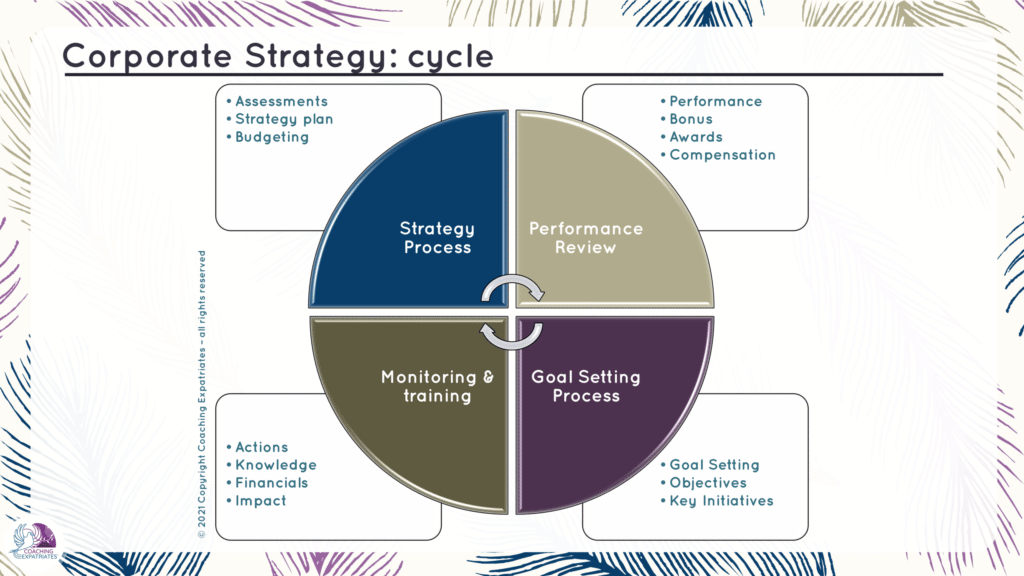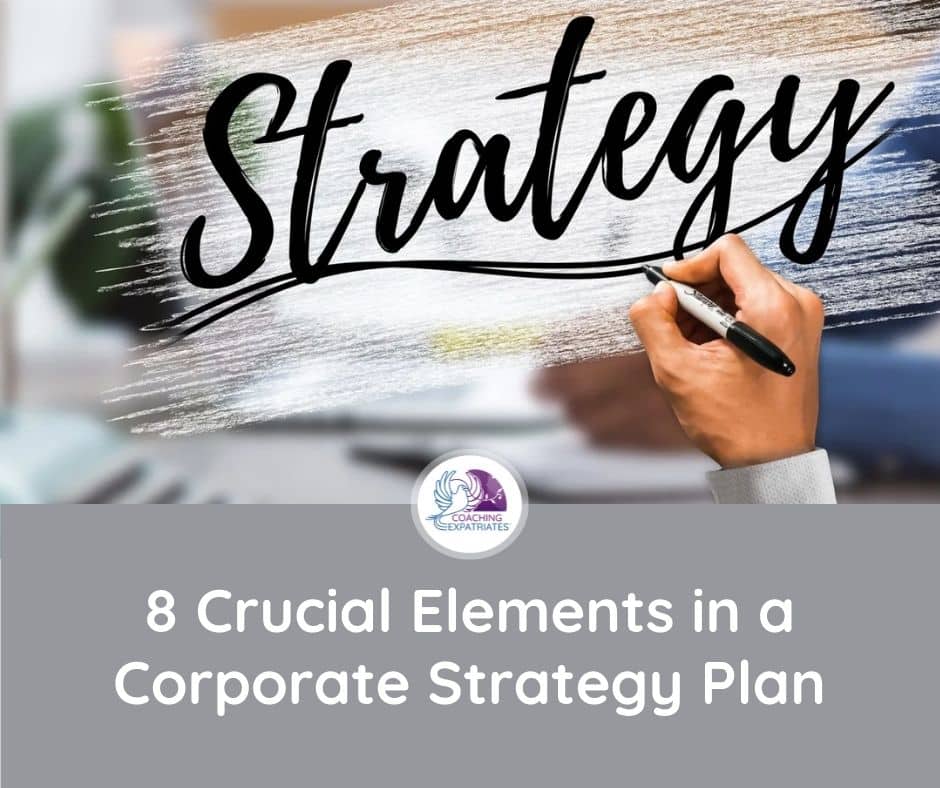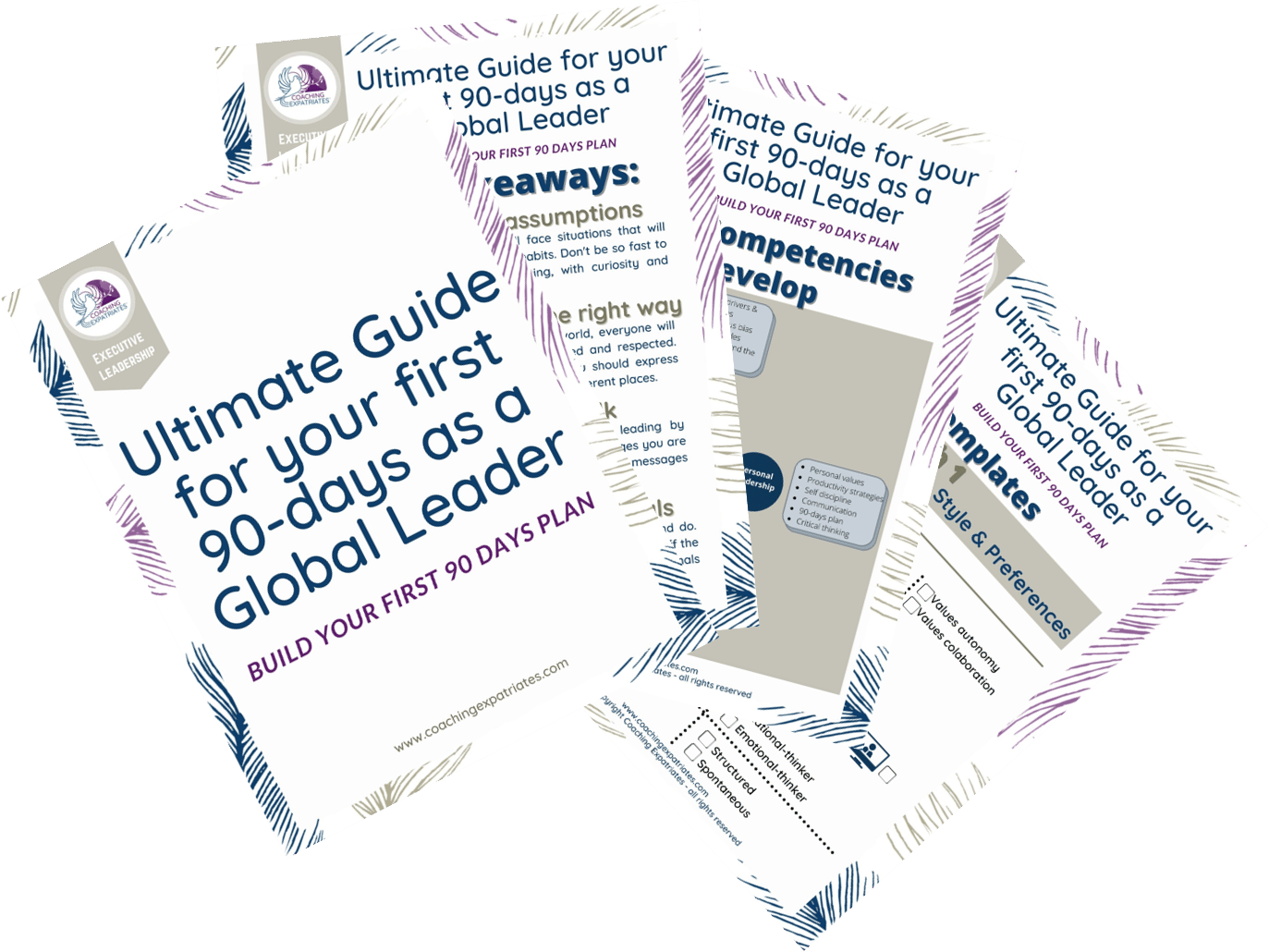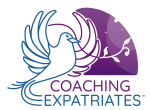As I said in my last post about the 3 Principles for creating your corporate strategy, there are no specific frameworks or rules for outlining your Corporate Strategy Plan process. Most companies follow a similar pattern and have a similar chain of events. And this entire process usually involves 8 crucial elements.
The key elements in a Corporate Strategy Plan are:
1- Vision & mission statements
The reason why having a clear vision and mission is that they will become the company’s north pole. You will know your direction, no matter where you are if you have a clear mission and vision statement. So ask yourself this: “what do I want my company to accomplish in this world?” and “what do I want my company to be known for?” As said in the previous post about a strategy statement, here, the same thing applies: the simpler, the better. It has to be clear for anyone to understand.
2- Core Values
Core Values are basic, fundamental beliefs that guide and motivate attitudes and actions. Values help you drive action in a more purposeful way. If you are delivering a package, you may use different resources and efforts if you value speed versus safety and vice versa. Values drive behavior and action. And you want your employees to have actions and behaviors that are aligned with the company’s vision. Values help employees understand what a company is expecting from their behavior.
3- Cultural Drivers
Cultural drivers are the main characteristics and policies that a company wants to have, which helps create and solidify a Company’s culture. These drivers are how you display and show up with the company’s values. For example, if a company values excellence, one cultural driver could be that employees are process-oriented or customer-oriented. These are 2 different ways to ensure excellence.
If your company creates life-support products, you might want to have a process-oriented culture and ensure your products’ perfect reliability. They can’t fail, or people die. If you are a massage company, you might want to have a customer-orientated culture, as the step by step process of your service is not as critical as your customer’s needs for that service. So you customize to satisfy.
4- Long-term Goals and Strategic Objectives
Long term goals are usually set so that you can be closer to your mission. Some things can’t happen overnight. It requires a lot of effort, a lot of time, accumulated experience, etc. If you set only short-termed goals, you might detour too much or too often. Long-term goals keep a company honest about where they are aiming to go.
5- SWOT Analysis and other forms of assessment
Assessments are forms of measure. You might know where the north pole is, and you might see the beacon’s lights in the distance, but if you don’t have a measure of where you are, you’ll have no idea how long it will take to get there. Assessments will help you map what is going on right now to do a gap-analysis and get a closer understanding of what you need to do going forward. SWOT-Analysis is an assessment undertaken by organizations to identify their Strengths, Weaknesses, Opportunities, Threats. I am citing this one famous, but there are an incredible amount of different types of assessments that help leverage information to create strategic plans.
6- Yearly objectives
Sometimes it is overwhelming to set a long term goal and not know where to start. In the recent South Korean series “Start-up,” featured on Netflix, a team of 3 super-brains teamed up to create a company. Their company has not made any sales whatsoever, so long it existed because they had the perfect mission, vision, and long term plan, but no set of short term objectives or tactical plans. They were literally waiting for customers to come in. This is called in the growth-business industry “hope marketing.”
When we break that beautiful vision into smaller feats that we want to accomplish, things become less overwhelming and seem much more feasible. It’s like laying out stepping stones and stepping in each, one at a time. Each of these stepping stones is your yearly objectives.
Yearly objectives are actions and initiatives that are the smaller steps in the bigger plan. Each step will take you to that “beacon.” Each manager in the company has to approve their employee’s goals and objectives, ensuring that that step is actually part of the bigger pathway to the beacon. One important thing to note is the number of goals. My recommendation is always to have between 5 to 8 goals. If you have too many, you end up not focusing on any one of them. Really. Your performance will be far inferior compared to what it would have been if you focused on fewer things.
I once inherited a team in the middle of the performance review cycle. One of the team members had 18 goals for that past year, none of which he accomplished nicely (or at all). He was a brilliant man. Very experienced. But also very overwhelmed. His performance was considered by the company terrible. And I was tasked to tell him that. His problem was that he confused goals with processes. Indeed, he had many functions he was responsible for. But he confounded completing those processes and exercising his functions with its intended goals.
Processes always have a goal behind them. Is good onboarding your goal? No, your goal is to help employees quickly and smoothly transition into the company and provide value-add. Is a well-received Ad Campaign your goal? No, it might be creating greater brand awareness. And this goal might be connected to a Company’s long-term goal of “being top of mind for artificial intelligence,” for example.
7- Key initiatives and actionable plans
Once the goals are set, the organization and each employee have to define the actions to meet that goal. Your actionable plan is like a recipe: what steps you must take and what you have to do to meet that goal? These will be your key initiatives to meet your yearly goals and objectives.
8- Budget
I find it curious how many companies dissociate the budgeting process and strategy process. They must go along as one impacts the other. Your key initiatives will cost money. How much is that? What is the return on investment for that? Budget is an essential element, and it must be incorporated into your strategic plan.
Cool, we covered the main elements of a corporate strategy plan. Now, let’s talk about a step by step process to put this all together into a framework that you can use to create your own Corporate Strategy Plan process.
Step by Step guide for creating an Annual Corporate Strategy Plan Process.
Most companies have a set of chained-events that comprise their corporate strategy planning process. They usually start from the top executives and board members and cascade all the way down to all levels of the organization. And this usually happens before the Performance Review process (evaluating all employee’s performance related to the work performed in the previous year), which is always followed by the current year’s Goal Setting process. Although these other processes are not necessarily part of a Corporate Strategy Plan process, which we will outline step by step below, they are part of the Corporate Strategy Cycle.

In this quick guide, we will outline a recommendation for small and medium companies to implement a strategic planning process in their companies, which relates to the top left quadrant, in the image above.
Step 1: Engaging the top level in Corporate Strategy
Session 1 - Corporate Strategy assessment
In early January or a couple of months before the year ends, engage your top executives in a Corporate Strategy Assessment. Whether your company will hire an external firm to map and prepare the assessment or internalize and create the assessment yourself, you have to make sure your top executives are involved. They have to evaluate market positioning, product strategy, market barriers, SWOT, customer satisfaction (or NPS), and employee satisfaction, among other metrics that will empower you to elaborate on your strategy.
Session 2 - Assessment Analysis and Discussion
Once you have all the data and metrics that assessed your company’s aspects, it is time to put them together and analyze what they really mean for your company and strategical direction. Once again, whether you hire external consultants to provide you in-depth analysis of the data or have specialized folks internally doing this for you, it is up to your company’s decision.
Session 3 - Vision, Mission, Values & Cultural Drivers review
Sounds boring, right? But the fine-tuning vision, mission, values, and cultural drivers are like fine-tuning an instrument before play. If your instrument is fine-tuned, it depends on your competency in playing that instrument to make a beautiful sound. If your instrument is awfully fine-tuned, you can be a top expert in that instrument, and still, your music will hear like crap. The same thing goes for strategy. Fine-tuning these items are crucial for reliable and aligned strategy creation.
After the assessment discussion and the first few recommendations, evaluate your mission, values, and drivers, and see if they are still what you are looking for as main company drivers.
Session 4 - Long-term Goals and Objectives setting
Setting long term goals and objectives keep your executives honest. Reaching short-term goals is fantastic to drive credibility, promotions, and reputation, but the short-term initiatives can often be a step back from the long-term goals. Or a side step. Understanding how this year’s initiatives will impact the long-term goal is always crucial. So setting long-term goals always come first.
Session 5 - 1-year goals and objectives
Once you have long term goals, it’s time for your top executives to determine their next year’s focus. They will do so by selecting what their goals and objectives for the next year will be. The entire organization will then use these goals as drivers to help create their own. So, it is imperative that these goals and objectives are very clear and simple to understand. As mentioned before, too many goals make things confusing and detract focus. Make sure each executive has their own 5 to 8 goals.
Session 6 - Key Initiatives & drivers aligned with strategy & budget
A goal is a target, something that you want to achieve. Then, you have to be more tactical and define which initiatives and drivers will help you get what you want. And along with that, understand what the budget implications are. Some initiatives are cool and very aligned with the overall strategy but may be cost-prohibitive at the moment. Executives will have to make decisions to either fund these initiatives another way or carve the initiatives down to be more aligned with the budget. Another option when the budget is restricting is to do things in phases.
Step 2: Cascading down through team-building events
As you can see, these 6 events from step 1 will take some time to complete. And it depends on the company’s size and agility. Some companies take 2 full months to go through this process, while others can do it in the course of 2 weeks. Strategy is important, so don’t rush things. Also, consider that if your company is doing this process for the first time, it will take a little longer. Be gracious. Learning new processes takes some time. Once this process gets more solidified in the company, and people get its hang, it will become faster and more productive.
Once step 1 is completed, it is time to cascade all this information down to all organization levels, according to each information clearance. Not everybody will have access to everything, of course. But everybody has to have proper general strategical directions.
In step 2, you will invite every department in the company to create team-building meetings. Depending on the group’s size, to cover all the below sessions, this may take a full week. Smaller groups might only take 2 days.
Usually, companies hire facilitators to help conduct these meetings. The idea is to bring someone from outside, exempt from judgment, so that every employee in the team feels empowered and free to say what they really want.
Here is what the event’s agenda would look like:
Meeting 1: Communication of what the high-level strategy is.
Meeting 2: Communication of what specific goals and objectives that the company wants to accomplish by the end of the current year.
Meeting 3: Vision, Mission, Values & Cultural drivers refresher and discussion (make it fun; introduce a Jeopardy game or another team building game, and provide prizes)
Meeting 4: group breakout session
- Provide an ice-break exercise for team-building
- Ask the team to provide their key team input of initiatives based on what the company wants to accomplish
Meeting 5: Individual breakout session
- Request each individual in the team to individually outline what their own key initiatives and objectives will be, based on the teams’ initiatives
- Reconvene the group and ask each participant to pitch their goals and key initiatives quickly
Final remarks on the corporate strategy planning process
When this becomes a stable process – and you help each employee in the company understand its strategy and how their specific team will help accomplish that – it will become easier for them to create and set their own individual goals for the current year.
When your company’s Goal Setting cycle comes (bottom right in the image), your employees will have a much clearer picture of what they need to achieve, how they will measure this, the priorities, and the timeframe that they have for each initiative. The conversations with their managers will flow quicker too, expectedly.
Download our template for Goal Setting and Key Initiatives Definition. It includes a quick cheat sheet of the entire framework outlined above. This template should be used in meetings 4 and 5, in step 2, so that teams and employees can fill out their main goals and initiatives. To download this template, fill in the form below.
Hopefully, this framework helps you get some ideas so that you can create or improve your own process. It’s not intended to be exhaustive but to provide some helpful insights for you, the reader.
If you enjoyed this post, please make sure to share it with others who might be interested in the topic. Consider subscribing to our newsletter, if you didn’t do so yet, by filling the form below. We send only 1 email per week, we never share your information, and we focus our content on helping global leaders become more productive, have better habits, and set their mindsets for success.
Do you have questions? Feel free to contact us.







